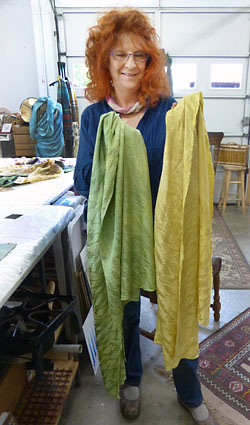home | internet service | web design | business directory | bulletin board | advertise | events calendar | contact | weather | cams

 Sara Ashford shows a scarf dyed by “flower bashing”. Sara Ashford shows a scarf dyed by “flower bashing”.Picking Colors In a while, local artist Sara Ashford will be making dyes from a garden on the TwispWorks grounds for her art and clothing. Phase one of dye garden development is to lay out the garden, make the pathways and improve the soil. The dirt in the old Forest Service compound has been tested and declared chemically OK, she said, but it needs to be built up. Ashford, an expert on plant and mineral dyes, is relying on Theresa Miller, a local gardener with a lot of experience, for garden expertise. “I have given Theresa a huge list” of plants that provide dye, she said.  Sara Ashford shows two scarves dyed using local plants. Adding indigo to a local plant dye created the green color. Sara Ashford shows two scarves dyed using local plants. Adding indigo to a local plant dye created the green color.“We’re about half way there on design,” said Miller. “it’s a three-year project. By the time the hardscape’s done, the plants are in and we start harvest.” Their immediate goal in the fenced garden space on the south end of TwispWorks is to pull the weeds, cover the soil with a fiber mat and get a low-volume, low maintenance watering system in place, Ashford said. On June 7 Ashford and Miller are inviting friends and anyone interested to come by the studio and lend a hand at the garden preparations. “We would love some friends to help. Sara’s providing the drinks and chips,” Sara smiled. TwispWorks welder Jerry Merz is helping out: he is teaching students at the Independent Learning Center to weld as they build a composting bin for the dye garden. “They designed it,” said Ashford. “This is awesome.” “In the fall, we’ll put in some perennials,” Ashford said. During the second and third year, Ashford envisions raised beds for annuals, maybe a couple structures such as a teaching area with a roof, and new fencing—all in time. Ashford and Miller may eventually expand the garden southward, closer to Highway 20 and Hank’s Grocery Store.  Local sage sits in a back room at the studio, ready to be used to dye cloth. Local sage sits in a back room at the studio, ready to be used to dye cloth.The plants from the TwispWorks dye garden can be carefully squeezed and/or cooked into a mash or liquid that will color cloth. Or, Ashford can go a more direct route: “flower bashing.” She lays plants and flowers on cloth (usually cotton, linen, wool or silk) and mashes them until their juices are absorbed by the material—leaving in imprint of the leaves and flowers in the plant’s own dyes. But “flower bashing” dyes are not strong, and she has found that they tend to wash out. Ashford said she never tires of researching. “It’s too exciting,” she said. “You have to know about the alchemy…to understand how to extract the color and get it into the material, you have to understand how to make things more or less alkaline or acidic. “ Before she found space at TwispWorks space she was experimenting and dyeing at home in an unheated shed with no water, but it wasn’t working so well. “I was driving my family crazy,” she said. “I was driving myself crazy.” Her knowledge and skills are appreciated in more than this country: her art was recognized in a juried art show in China last year. She was not able to travel to see her works displayed there, but she did get receive a certificate and her work was published in a book about the show.  A piece of art hanging on the studio wall shows complicated dye work. A piece of art hanging on the studio wall shows complicated dye work.All of Ashford’s colors come from “natural earth and botanical dyes,” she said, and “a lot of my stuff is many, many layers,” with different dyes going onto the piece one at a time. “I collect a lot of wild stuff,” she said, and all of her dyes are made from plants or minerals from the earth. But not all the plants and dirt she uses come from the Methow Valley. Many Methow Valley plants good for dyes give shades of yellow, orange, tan and brown, she said. But some dye colors are harder to find locally. For instance, there are “not very many long-lasting greens” she said. So she has become expert at using indigo, a plant that provides a blue dye through a difficult process she learned from a Frenchman, Michael Garcia. Indigo mixes well with the local plant dyes—yellowish—to make greens. Ashford is offering an indigo dying workshop in late June at her TwispWorks studio. Ashford sells scarves at Sun Mountain Lodge, and sells both art and clothing from her studio at TwispWorks. She’s there a lot, she says, and has an open studio where visitors are welcome. And she’s committed to being at her studio on Saturdays from 10:00 until 1:00. Her business is named Culler (pronounced "color") Studios, which is her maiden name. “I like showing what I do and teaching people,” Ashford concluded. 6/3/2013 Comments
|